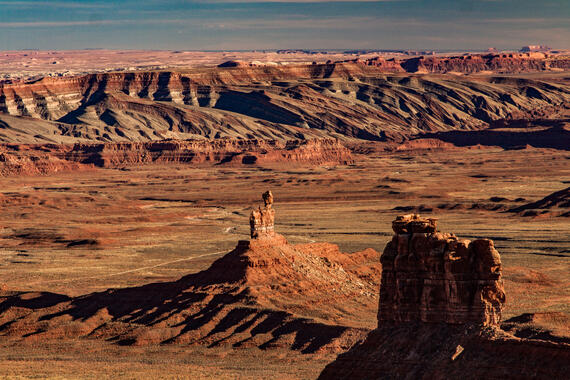From the Magazine: Bears Ears National Monument

A proposed government plan puts sacred lands and sites of the indigenous people of North America at risk.
The treasures of Bears Ears National Monument, located in modern-day southeast Utah in the United States, include thousands of ancient cliff dwellings, community centers, rock paintings and artifacts. They are scattered through the deep, twisting canyons, in caves, and perched on narrow ledges high up on sheer rock faces. Bears Ears remained undisturbed until the mid-nineteenth century, when Anglo settlers began to explore the landscape following the removal of its Native American residents. Located on a plateau that is today called Cedar Mesa, the ancestral land of indigenous tribes has been largely owned and managed by federal and state government since the early twentieth century. But today, its future is uncertain.
At the behest of the Bears Ears Intertribal Coalition representing five indigenous tribes, which had steadfastly advocated for protection of their ancestral lands, President Obama designated 1.35 million acres of southeast Utah as the Bears Ears National Monument in December 2016, one of his last acts in office. A year later, the new president reduced the site to just 300,000 acres.
The proposed management plan for the reduced area, released in August 2019, permits the installation of utility lines and access roads, the use of recreational off-road vehicles, and cattle grazing. In the de-designated areas, it allows mining and drilling for oil and gas. In addition to concerns stemming from the management plan, looting, vandalism, and desecration of burial sites are known to occur throughout the greater Bears Ears area.

In the face of burgeoning visitation—now estimated at 450,000 people per year—paired with detrimental activities and natural degradation of archaeological sites, the challenge is formidable. Nevertheless, a local group has been able to implement a variety of protective measures at selected sites, having established a viable working relationship with government and collaborating with regional Tribes and Pueblos. Friends of Cedar Mesa, formed a decade ago to ensure the respect and protection of natural and cultural sites in the Bears Ears region, has successfully carried out condition assessments, documentation, stabilization, conservation, installation of interpretive signage, and where necessary, protective fencing.
It is imperative that the voice of the Tribes and Pueblos is not only heard but taken seriously. By including Bears Ears on the 2020 World Monuments Watch, we call for government to reconsider its plan that will harm rather than protect the sacred lands and sites of the indigenous people of North America. Thanks to generous support from the Butler Conservation Fund, WMF will partner with Friends of Cedar Mesa to support and strengthen their shared stewardship of Bears Ears and create a participatory approach to its conservation.
